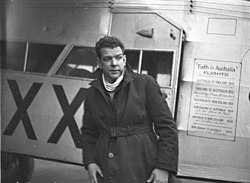| Charles Ulm | |
|---|---|
 Charles Ulm in 1934, in front of his Avro X VH-UXX "Faith in Australia". The text on the side of the aircraft lists all the long-distance flights it has made. | |
| Born |
18 October 1898 Melbourne, Australia |
| Died | 3 December 1934 (aged 36) |
| Cause of death | Disappeared during flight |
| Nationality | Australian |
| Known for |
Trans-Pacific flight Setting the speed record from England to Australia at 6 days, 17 hours and 56 minutes |
| Awards | Air Force Cross |
Charles Thomas Philippe Ulm AFC (18 October 1898 – 3 December 1934) was a pioneer Australian aviator.
World War I[]
Ulm joined the AIF in September 1914, lying about his name and age. He fought and was wounded at Gallipoli in 1915, and on the Western Front in 1918.
Charles Ulm was married twice. In 1919 he married Isabel Amy Winter. After divorcing his first wife, in 1927 he married Mary Josephine Callaghan.
Partnership with Charles Kingsford Smith[]
Ulm is best known for his partnership with Sir Charles Kingsford Smith, and was Kingsford Smith's copilot on many of his famous flights, including the 1928 first crossing of the Pacific in the Southern Cross. Ulm was the "business brains" in the partnership, and acquired the funding necessary for the journey.[1] Ulm was also Kingsford Smith's partner in establishing Australian National Airways.
Later flights and disappearance[]
After the failure of Australian National Airways, Ulm bought one of the airline's Avro X aircraft for himself, and named it Faith in Australia. In this aircraft in 1933, Ulm set the speed record from England to Australia at 6 days, 17 hours and 56 minutes, and made several trans-Tasman flights.
In 1934, flying in Faith in Australia, Ulm carried the first official airmail from New Zealand to Australia,[2][3] and the first official airmail delivery from Australia to Papua New Guinea.[4]
Ulm established a new company in September 1934, Great Pacific Airways Ltd, intending to operate a San Francisco-Sydney air service. Ulm disappeared in December 1934, together with copilot George Littlejohn and navigator Leon Skilling, on a test flight from Oakland, California to Hawaii in VH-UXY Stella Australis, an Airspeed Envoy. It is believed an unexpected tailwind and bad weather caused them to fly past the Hawaiian islands in the dark.[5] The wind was about 35 knots from the south-southeast and the aircraft may also have been pushed north of the islands.[6] At about 10 am local time on 3 December, after sending a series of Morse coded radio messages to Hawaii over five hours advising that they were lost and running out of fuel, the Envoy ditched into the sea. Despite an extensive and immediate search by aircraft and 23 naval ships, no trace of Stella Australis or her crew was ever found. Ulm had chosen not to carry a life raft on board, preferring to save weight and predicting that the aircraft would float for two days if it were forced to land on the water.[5]
The plane had been customized by Airspeed to meet Ulm's own specifications; Airspeed's manager, Nevil Shute Norway, suggested in his autobiography that the internal cabin design may have contributed to the navigational problems, because the inexperienced navigator/wireless operator (who had been a ship's officer) had to sit in the rear compartment behind the large petrol tank and some distance from the pilot. Ulm communicated by speaking tube but could not see the charts or calculations (this arrangement had been chosen by Ulm instead of having the navigator in the cramped space in front of the tank with the pilot and co-pilot).[7]
Tributes[]
In 1978 he was honoured on a postage stamp issued by Australia Post depicting Ulm and the Southern Cross.[8]
In November 2008 Qantas announced that it would be naming one of its Airbus A380s after Charles Ulm in recognition of his contribution to the aviation industry.[9] This A380 (registration: VH-OQG) entered service on 3 November 2010.[10]
Sydney Airport former office building was known as the Charles Ulm Building, until it was replaced by the Central Terrace Building in the 2000s.
In 2019 Sydney Airport announced that its two corporate office buildings would be renamed as part of the airport's centenary celebrations. As part of this change the former Customs House was renamed as the Charles Ulm Building.[11]
See also[]
- List of people who disappeared mysteriously at sea
References[]
- ↑ "7:30 Report story on Ulm". http://www.abc.net.au/7.30/content/2003/s875609.htm.
- ↑ "Ulm and aircraft (photos)". Poverty Bay Herald in Papers Past (New Zealand). 16 April 1934. https://paperspast.natlib.govt.nz/newspapers/PBH19340416.2.132?end_date=31-12-1934&page=2&query=Charles+Ulm&start_date=01-01-1934.
- ↑ "Ulm delivers message to PM Forbes (photos)". The Evening Post (New Zealand). 14 May 1934. https://paperspast.natlib.govt.nz/newspapers/EP19340514.2.50.2?end_date=01-07-1934&query=Charles+Ulm&start_date=01-01-1934.
- ↑ Ellen Rogers collection highlight: National Museum of Australia
- ↑ 5.0 5.1 Gwynn-Jones, Terry (1989). On a Wing and a Prayer. University of Queensland Press. ISBN 0-7022-2193-7.
- ↑ Clarence S. Williams, "What Happened to Ulm," Los Angeles Times Sunday Magazine, 30 December 1934
- ↑ Nevil Shute, Slide Rule, p 200
- ↑ http://www.australianstamp.com/images/large/0012170.jpg
- ↑ "Archived copy". http://www.qantas.com.au/regions/dyn/au/publicaffairs/details?ArticleID=2008%2Fnov08%2F3852.
- ↑ http://www.airliners.net/photo/Qantas/Airbus-A380-842/1847706/M/
- ↑ "Aviation pioneers honoured for Sydney Airport centenary". St George and Sutherland Shire Leader. 19 June 2019. https://www.theleader.com.au/story/6225806/aviation-pioneers-honoured-for-sydney-airport-centenary/.
External links[]
- Listen to recordings of aviators such as Charles Kingsford Smith, Charles Ulm, Amy Johnson and Bert Hinkler talking about their journeys on the National Film and Sound Archive of Australia's website: 'Our Heroes of the Air'
- Photos from an album kept by Ulm's wife Mary
| Wikimedia Commons has media related to Category:Charles Ulm. |
The original article can be found at Charles Ulm and the edit history here.